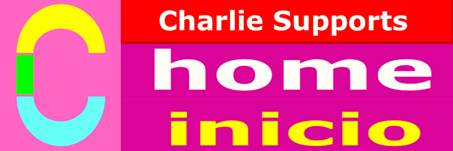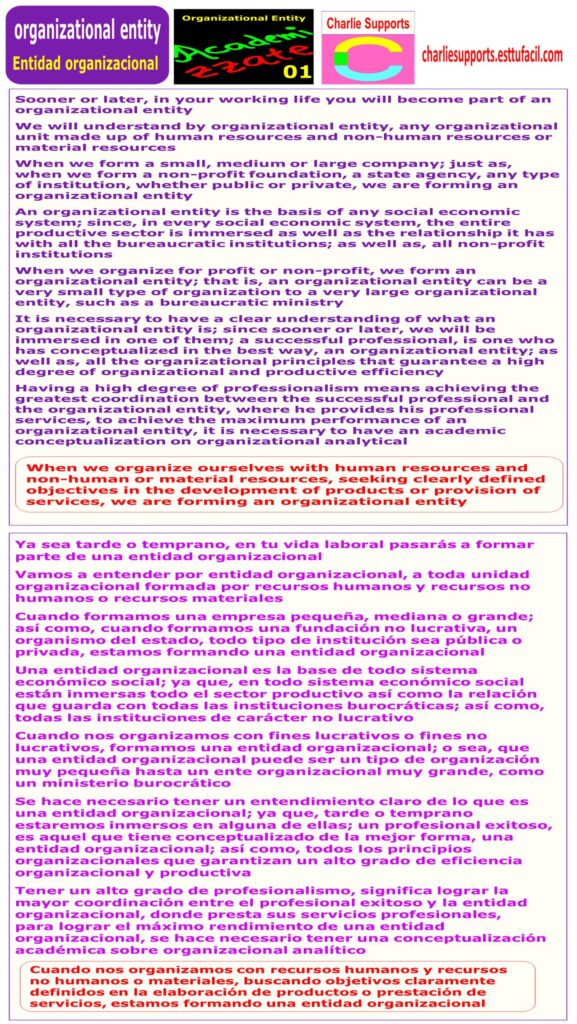
Sooner or later, in your working life you will become part of an organizational entity
We will understand by organizational entity, any organizational unit made up of human resources and non-human resources or material resources
When we form a small, medium or large company; just as, when we form a non-profit foundation, a state agency, any type of institution, whether public or private, we are forming an organizational entity
An organizational entity is the basis of any social economic system; since, in every social economic system, the entire productive sector is immersed as well as the relationship it has with all the bureaucratic institutions; as well as, all non-profit institutions
When we organize for profit or non-profit, we form an organizational entity; that is, an organizational entity can be a very small type of organization to a very large organizational entity, such as a bureaucratic ministry
It is necessary to have a clear understanding of what an organizational entity is; since sooner or later, we will be immersed in one of them; a successful professional, is one who has conceptualized in the best way, an organizational entity; as well as, all the organizational principles that guarantee a high degree of organizational and productive efficiency
Having a high degree of professionalism means achieving the greatest coordination between the successful professional and the organizational entity, where he provides his professional services, to achieve the maximum performance of an organizational entity, it is necessary to have an academic conceptualization on organizational analytical
When we organize ourselves with human resources and non-human or material resources, seeking clearly defined objectives in the development of products or provision of services, we are forming an organizational entity

The first thing or element we must know to have a full understanding of the organizational entity is to find the analytical part that brings us closer to the academic concept
If we remember, when the analytical number was conceptualized, the need was to be able to quantify, to be able to know how much of something I have; in the case of an organizational entity, the need is how to manage to interact human resources and non-human resources to achieve something specific
For a long time in the course of human history, there was no understanding of how to most efficiently and effectively organize human resources with non-human resources and achieve something amazing
If we go back to the time of the ancient Egyptians, we can appreciate the analytical inference of organizational entity; since, the Egyptians managed to organize themselves in such a way, to build the great pyramids of Egypt
Achieving this great organizational feat requires a large amount of human resources; as well as, a large amount of material resources, transporting the materials, giving them the shape to be the adjustments in the placement and above all being able to orient that great building according to the path of the sun; since the sun had the ability to illuminate specific points of the pyramid; as well as, use the projection or shadow resulting from the sun, to measure the hours of the day and other
By analytically inferring, we establish that an organizational entity can be a thinking analytical entity and an unthinking analytical entity; when, we managed to form a organizational entity; that is, human resources with non-human resources, but we do not have the organizational management capacity, we say that the organizational entity is non-thinking, it lacks all kinds of organizational management capacity
Only human resources have the ability to reason and form thinking organizational entities; robotics and other technology, do not have the ability to reason, they are operational
A thinking organizational analytical entity is the one that has organizational management capacity and a non-thinking organizational analytical entity is the one that lacks any organizational management capacity, we can also call it as an operational organizational entity
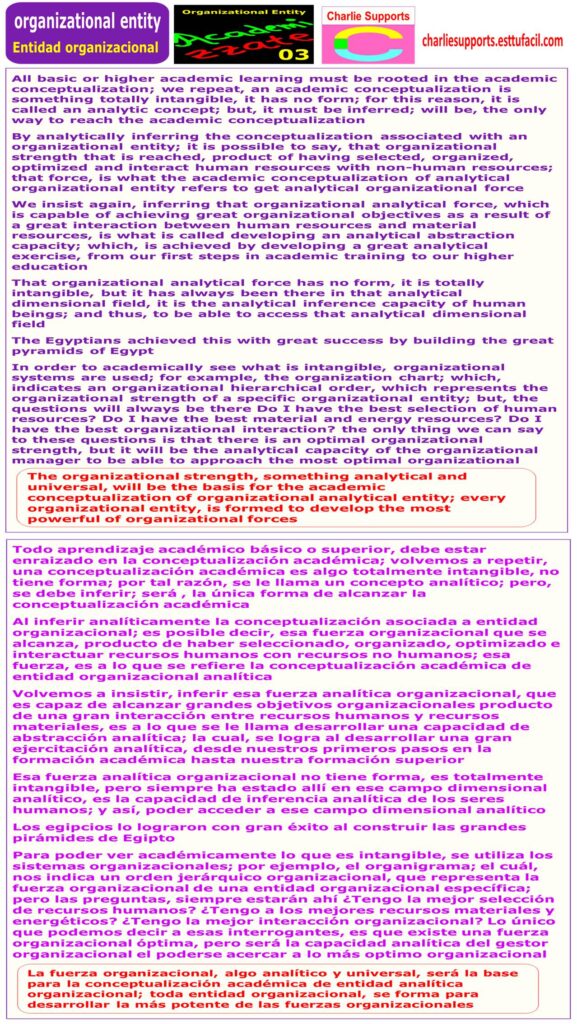
All basic or higher academic learning must be rooted in the academic conceptualization; we repeat, an academic conceptualization is something totally intangible, it has no form; for this reason, it is called an analytic concept; but, it must be inferred; will be, the only way to reach the academic conceptualization
By analytically inferring the conceptualization associated with an organizational entity; it is possible to say, that organizational strength that is reached, product of having selected, organized, optimized and interact human resources with non-human resources; that force, is what the academic conceptualization of analytical organizational entity refers to get analytical organizational force
We insist again, inferring that organizational analytical force, which is capable of achieving great organizational objectives as a result of a great interaction between human resources and material resources, is what is called developing an analytical abstraction capacity; which, is achieved by developing a great analytical exercise, from our first steps in academic training to our higher education
That organizational analytical force has no form, it is totally intangible, but it has always been there in that analytical dimensional field, it is the analytical inference capacity of human beings; and thus, to be able to access that analytical dimensional field
The Egyptians achieved this with great success by building the great pyramids of Egypt
In order to academically see what is intangible, organizational systems are used; for example, the organization chart; which, indicates an organizational hierarchical order, which represents the organizational strength of a specific organizational entity; but, the questions will always be there Do I have the best selection of human resources? Do I have the best material and energy resources? Do I have the best organizational interaction? the only thing we can say to these questions is that there is an optimal organizational strength, but it will be the analytical capacity of the organizational manager to be able to approach the most optimal organizational
The organizational strength, something analytical and universal, will be the basis for the academic conceptualization of organizational analytical entity; every organizational entity, is formed to develop the most powerful of organizational forces
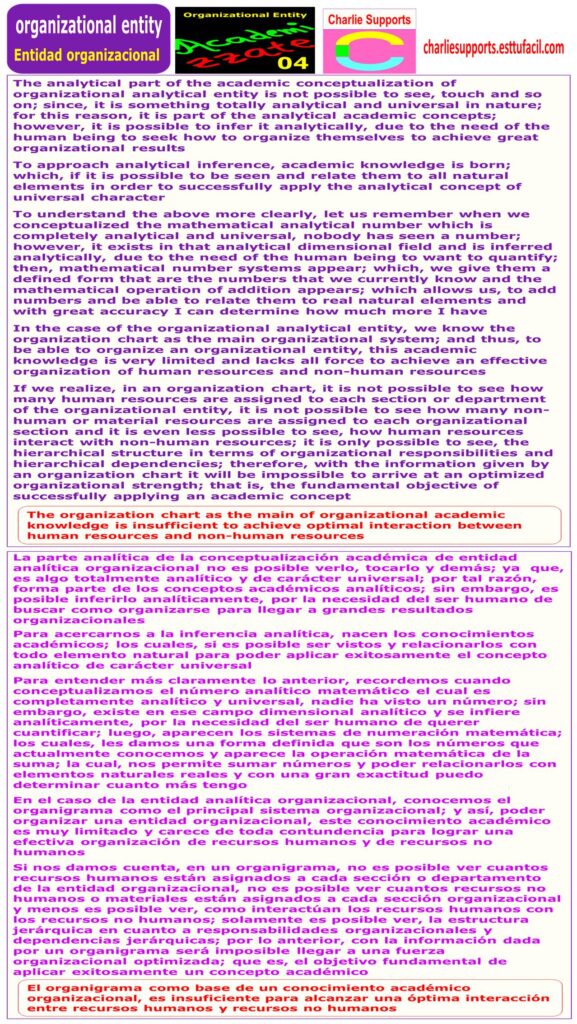
The analytical part of the academic conceptualization of organizational analytical entity is not possible to see, touch and so on; since, it is something totally analytical and universal in nature; for this reason, it is part of the analytical academic concepts; however, it is possible to infer it analytically, due to the need of the human being to seek how to organize themselves to achieve great organizational results
To approach analytical inference, academic knowledge is born; which, if it is possible to be seen and relate them to all natural elements in order to successfully apply the analytical concept of universal character
To understand the above more clearly, let us remember when we conceptualized the mathematical analytical number which is completely analytical and universal, nobody has seen a number; however, it exists in that analytical dimensional field and is inferred analytically, due to the need of the human being to want to quantify; then, mathematical number systems appear; which, we give them a defined form that are the numbers that we currently know and the mathematical operation of addition appears; which allows us, to add numbers and be able to relate them to real natural elements and with great accuracy I can determine how much more I have
In the case of the organizational analytical entity, we know the organization chart as the main organizational system; and thus, to be able to organize an organizational entity, this academic knowledge is very limited and lacks all force to achieve an effective organization of human resources and non-human resources
If we realize, in an organization chart, it is not possible to see how many human resources are assigned to each section or department of the organizational entity, it is not possible to see how many non-human or material resources are assigned to each organizational section and it is even less possible to see, how human resources interact with non-human resources; it is only possible to see, the hierarchical structure in terms of organizational responsibilities and hierarchical dependencies; therefore, with the information given by an organization chart it will be impossible to arrive at an optimized organizational strength; that is, the fundamental objective of successfully applying an academic concept
The organization chart as the main of organizational academic knowledge is insufficient to achieve optimal interaction between human resources and non-human resources
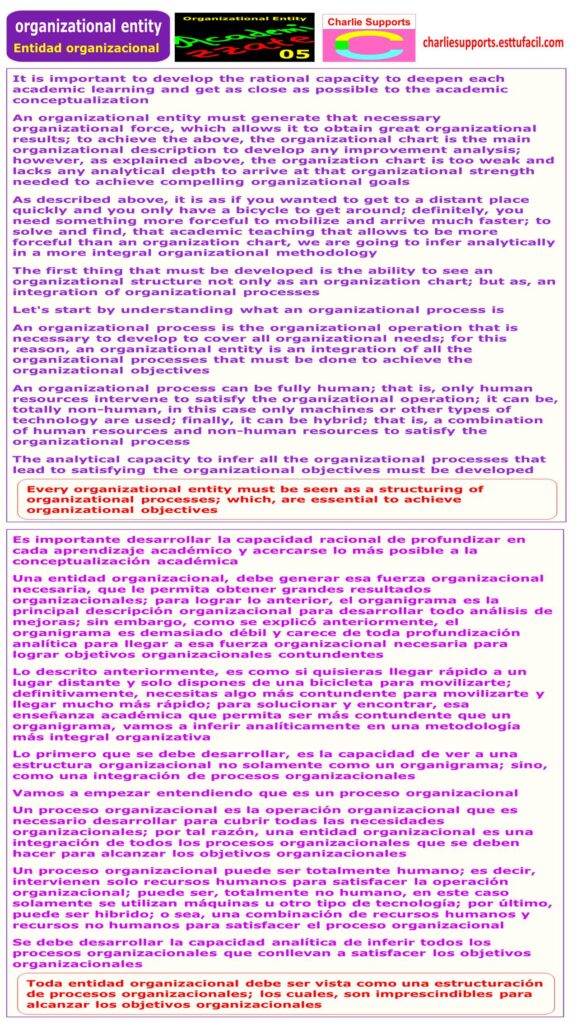
It is important to develop the rational capacity to deepen each academic learning and get as close as possible to the academic conceptualization
An organizational entity must generate that necessary organizational force, which allows it to obtain great organizational results; to achieve the above, the organizational chart is the main organizational description to develop any improvement analysis; however, as explained above, the organization chart is too weak and lacks any analytical depth to arrive at that organizational strength needed to achieve compelling organizational goals
As described above, it is as if you wanted to get to a distant place quickly and you only have a bicycle to get around; definitely, you need something more forceful to mobilize and arrive much faster; to solve and find, that academic teaching that allows to be more forceful than an organization chart, we are going to infer analytically in a more integral organizational methodology
The first thing that must be developed is the ability to see an organizational structure not only as an organization chart; but as, an integration of organizational processes
Let’s start by understanding what an organizational process is
An organizational process is the organizational operation that is necessary to develop to cover all organizational needs; for this reason, an organizational entity is an integration of all the organizational processes that must be done to achieve the organizational objectives
An organizational process can be fully human; that is, only human resources intervene to satisfy the organizational operation; it can be, totally non-human, in this case only machines or other types of technology are used; finally, it can be hybrid; that is, a combination of human resources and non-human resources to satisfy the organizational process
The analytical capacity to infer all the organizational processes that lead to satisfying the organizational objectives must be developed
Every organizational entity must be seen as a structuring of organizational processes; which, are essential to achieve organizational objectives

Wanting to obtain a great organizational strength, starting from an organization chart, will be something very limited; now, starting from a structuring of organizational processes, will be something much more forceful
Developing an organizational vision of processes corresponds to having a high development in analytical abstraction; which, is the product of having developed the ability to conceptualize
The first thing we must do to arrive at this structuring of organizational processes is to be able to identify three large groups of organizational processes
The first group of processes is the one that corresponds to all the organizational processes related to internal organizational specialized advisory operations; which, are used to maintain the legal-accounting order and market studies of the organizational entity; that is, we must separate all organizational operations related to accounting, auditing, business records, legal records, marketing
The second group of organizational processes that we must separate, are all those organizational processes, related to messaging, guardianship, cleaning, cafeteria; which, we must consider as important; but, they are not part of the core structuring of organizational processes
Being able to infer the core structuring of organizational processes will be fundamental; since, in this group of organizational processes all those fundamental organizational operations are located; which, give life to the organizational entity, in the elaboration of products or in the provision of services
The core structuring of organizational processes will be the equivalent of our human backbone; since, if our spinal column fails, it is impossible to remain standing; similarly, an organizational entity needs to have the most optimal selection of organizational processes that belong to that core structure
Inferring the core structuring of organizational processes, will be essential for their selection, interaction and optimization; and thus, get to develop that forceful organizational force
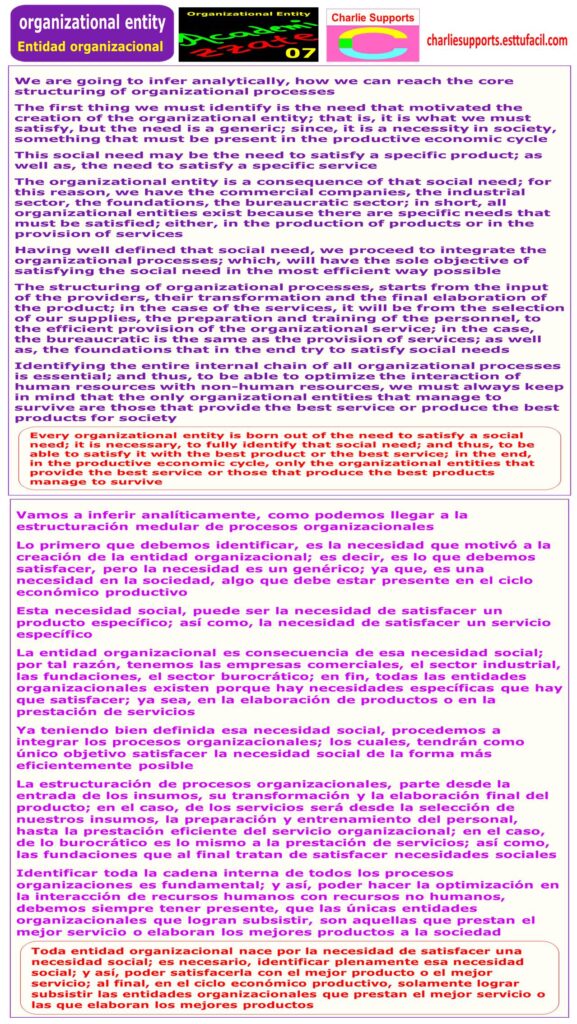
We are going to infer analytically, how we can reach the core structuring of organizational processes
The first thing we must identify is the need that motivated the creation of the organizational entity; that is, it is what we must satisfy, but the need is a generic; since, it is a necessity in society, something that must be present in the productive economic cycle
This social need may be the need to satisfy a specific product; as well as, the need to satisfy a specific service
The organizational entity is a consequence of that social need; for this reason, we have the commercial companies, the industrial sector, the foundations, the bureaucratic sector; in short, all organizational entities exist because there are specific needs that must be satisfied; either, in the production of products or in the provision of services
Having well defined that social need, we proceed to integrate the organizational processes; which, will have the sole objective of satisfying the social need in the most efficient way possible
The structuring of organizational processes, starts from the input of the providers, their transformation and the final elaboration of the product; in the case of the services, it will be from the selection of our supplies, the preparation and training of the personnel, to the efficient provision of the organizational service; in the case, the bureaucratic is the same as the provision of services; as well as, the foundations that in the end try to satisfy social needs
Identifying the entire internal chain of all organizational processes is essential; and thus, to be able to optimize the interaction of human resources with non-human resources, we must always keep in mind that the only organizational entities that manage to survive are those that provide the best service or produce the best products for society
Every organizational entity is born out of the need to satisfy a social need; it is necessary, to fully identify that social need; and thus, to be able to satisfy it with the best product or the best service; in the end, in the productive economic cycle, only the organizational entities that provide the best service or those that produce the best products manage to survive
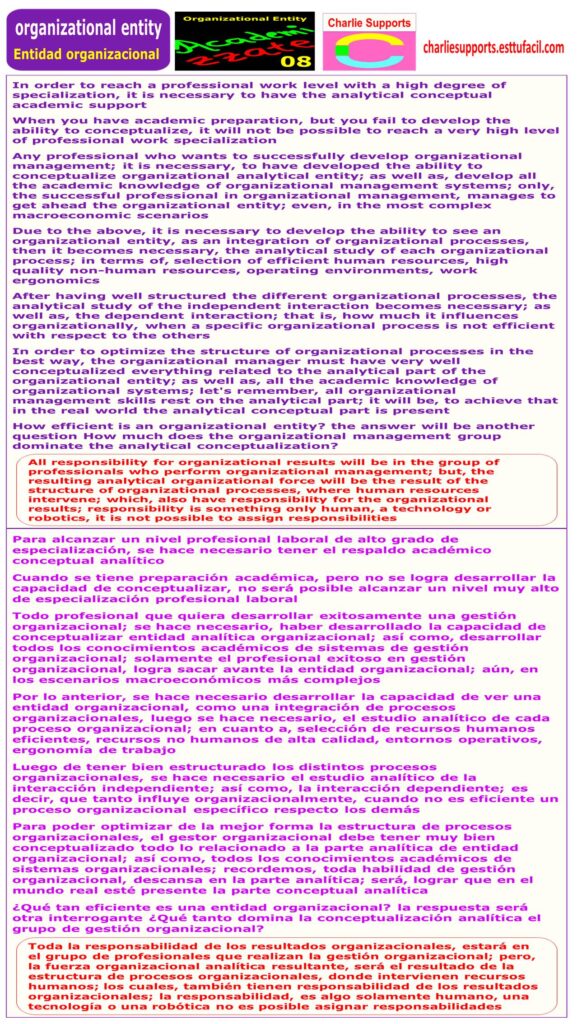
In order to reach a professional work level with a high degree of specialization, it is necessary to have the analytical conceptual academic support
When you have academic preparation, but you fail to develop the ability to conceptualize, it will not be possible to reach a very high level of professional work specialization
Any professional who wants to successfully develop organizational management; it is necessary, to have developed the ability to conceptualize organizational analytical entity; as well as, develop all the academic knowledge of organizational management systems; only, the successful professional in organizational management, manages to get ahead the organizational entity; even, in the most complex macroeconomic scenarios
Due to the above, it is necessary to develop the ability to see an organizational entity, as an integration of organizational processes, then it becomes necessary, the analytical study of each organizational process; in terms of, selection of efficient human resources, high quality non-human resources, operating environments, work ergonomics
After having well structured the different organizational processes, the analytical study of the independent interaction becomes necessary; as well as, the dependent interaction; that is, how much it influences organizationally, when a specific organizational process is not efficient with respect to the others
In order to optimize the structure of organizational processes in the best way, the organizational manager must have very well conceptualized everything related to the analytical part of the organizational entity; as well as, all the academic knowledge of organizational systems; let’s remember, all organizational management skills rest on the analytical part; it will be, to achieve that in the real world the analytical conceptual part is present
How efficient is an organizational entity? the answer will be another question How much does the organizational management group dominate the analytical conceptualization?
All responsibility for organizational results will be in the group of professionals who perform organizational management; but, the resulting analytical organizational force will be the result of the structure of organizational processes, where human resources intervene; which, also have responsibility for the organizational results; responsibility is something only human, a technology or robotics, it is not possible to assign responsibilities
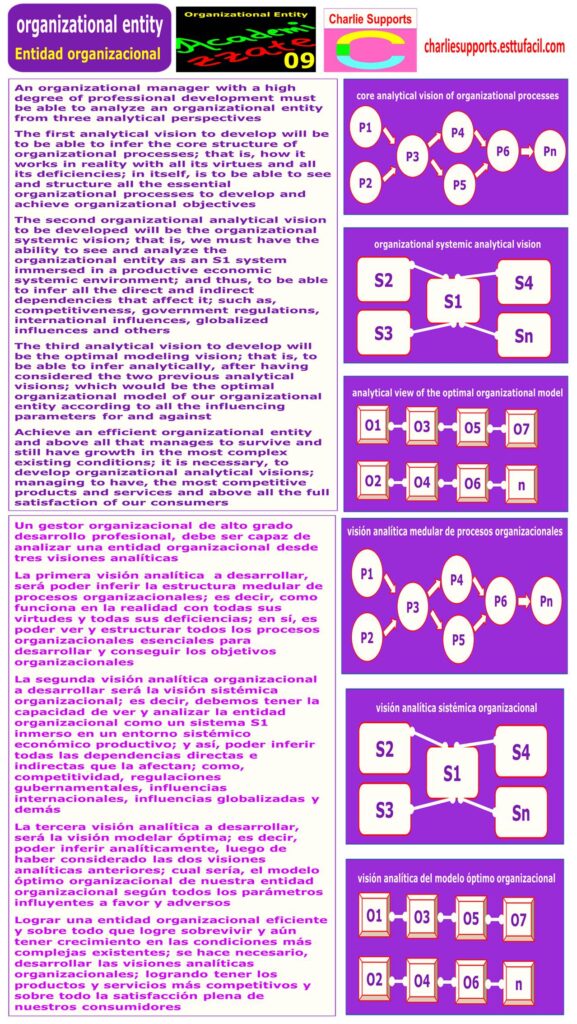
An organizational manager with a high degree of professional development must be able to analyze an organizational entity from three analytical perspectives
The first analytical vision to develop will be to be able to infer the core structure of organizational processes; that is, how it works in reality with all its virtues and all its deficiencies; in itself, is to be able to see and structure all the essential organizational processes to develop and achieve organizational objectives
The second organizational analytical vision to be developed will be the organizational systemic vision; that is, we must have the ability to see and analyze the organizational entity as an S1 system immersed in a productive economic systemic environment; and thus, to be able to infer all the direct and indirect dependencies that affect it; such as, competitiveness, government regulations, international influences, globalized influences and others
The third analytical vision to develop will be the optimal modeling vision; that is, to be able to infer analytically, after having considered the two previous analytical visions; which would be the optimal organizational model of our organizational entity according to all the influencing parameters for and against
Achieve an efficient organizational entity and above all that manages to survive and still have growth in the most complex existing conditions; it is necessary, to develop organizational analytical visions; managing to have, the most competitive products and services and above all the full satisfaction of our consumers
core analytical vision of organizational processes
organizational systemic analytical vision
analytical view of the optimal organizational model
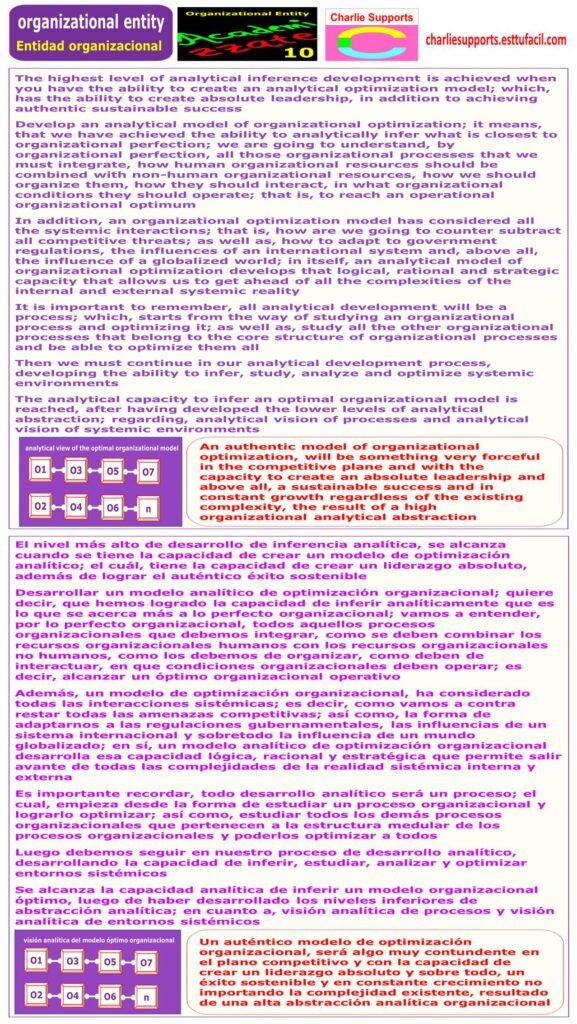
The highest level of analytical inference development is achieved when you have the ability to create an analytical optimization model; which, has the ability to create absolute leadership, in addition to achieving authentic sustainable success
Develop an analytical model of organizational optimization; it means, that we have achieved the ability to analytically infer what is closest to organizational perfection; we are going to understand, by organizational perfection, all those organizational processes that we must integrate, how human organizational resources should be combined with non-human organizational resources, how we should organize them, how they should interact, in what organizational conditions they should operate; that is, to reach an operational organizational optimum
In addition, an organizational optimization model has considered all the systemic interactions; that is, how are we going to counter subtract all competitive threats; as well as, how to adapt to government regulations, the influences of an international system and, above all, the influence of a globalized world; in itself, an analytical model of organizational optimization develops that logical, rational and strategic capacity that allows us to get ahead of all the complexities of the internal and external systemic reality
It is important to remember, all analytical development will be a process; which, starts from the way of studying an organizational process and optimizing it; as well as, study all the other organizational processes that belong to the core structure of organizational processes and be able to optimize them all
Then we must continue in our analytical development process, developing the ability to infer, study, analyze and optimize systemic environments
The analytical capacity to infer an optimal organizational model is reached, after having developed the lower levels of analytical abstraction; regarding, analytical vision of processes and analytical vision of systemic environments
An authentic model of organizational optimization, will be something very forceful in the competitive plane and with the capacity to create an absolute leadership and above all, a sustainable success and in constant growth regardless of the existing complexity, the result of a high organizational analytical abstraction
